Mycotoxins represent a huge economic cost to dairy farms
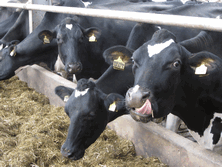 For the past 10 - 20 years
there has been a growing awareness of the huge economic loss caused to dairy and livestock farmers by
the presence of mycotoxins in feedstuffs.
For the past 10 - 20 years
there has been a growing awareness of the huge economic loss caused to dairy and livestock farmers by
the presence of mycotoxins in feedstuffs.
Moulds grow on crops, on conserved forages, in feed stores and on moist feeds. Moulds grow everywhere and produce mycotoxins that are highly toxic to livestock. Mycotoxins can target the liver, the digestive tract or the reproductive system. Symptoms can be wide ranging including decreased feed consumption, poor feed utilisation, weight loss, reduced milk yields, oestrogenic effects and infertility, scour, nervous disorders, inflammation, organ damage, tissue necrosis, haemorrhage, tumours and abortion.
The major mycotoxin producing fungi are Aspergillus, Fusarium, and Penicillium. Moulds produce mycotoxins which fall into the major classes, aflatoxins, zearalenone, trichothecenes, fumonisins, ochratoxin and ergot alkaloids. However in nature there may be well over 1 million fungal species and over 20,000 different mycotoxins. The Fusarium moulds can produce mycotoxins in the field before harvest producing deoxynivalenol (DON) and zearalenone, fumonisins and other mycotoxins. Aspergillus and Penicillium are thought of more as storage moulds.
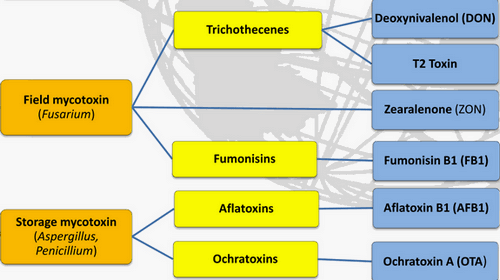
Mycotoxins can be detected in most forages, cereals and other crops. We can be confident that mycotoxins are present at varying levels in virtually all cattle diets.
Mycotoxins represent a huge economic loss to dairy farmers
Mycotoxins an invisible and largely ignored problem
Over 500 different mycotoxins have been identifies to date and often feeds contain many different mycotoxins. We know that mycotoxins are "toxins" and their insidious effects on cattle are deleterious, many and manifold. Yet the problem of mycotoxins in feed has been largely ignored. The widespread nature of the problem and the long term effects on cattle health and performance have not been fully appreciated.
We should recognise that most dairy cow diets will often contain multiple mycotoxins at any one time. These mycotoxins can and do affect animal performance and the profitability of UK dairy farms. Furthermore we should actively work to minimise the level of mycotoxin contamination in all feeds and to restrict the absorption of mycotoxins into the cows body.
Mycotoxins are a real problem, yet they have largely been ignored
A relatively small proportion of UK dairy farmers routinely include a mycotoxin binder in their milking cows, dry cow and youngstock diets year round. Routine use of a broad spectrum mycotoxin binder in all diets should be considered.
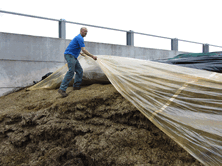 There
is also scope to reduce mycotoxin contamination in silage clamps through improved conservation techniques.
Harvesting crops before they become heavily contaminated, rapid wilting, reduced chop length, improved
consolidation and better clamp sealing to obtain a genuine air tight seal.
There
is also scope to reduce mycotoxin contamination in silage clamps through improved conservation techniques.
Harvesting crops before they become heavily contaminated, rapid wilting, reduced chop length, improved
consolidation and better clamp sealing to obtain a genuine air tight seal.
Many farmers take advantage of the latest silage additive technology In order to reduce the risk of mycotoxins in silage. In addition using the latest low transmission Oxygen Barrier films can also be expected to reduce but not eliminate the mycotoxin challenge in silages. A good standard of clamp face management is particularly important. Never feed spoiled silage or feeds with visible mould.
Testing feeds for Mycotoxins
Mycotoxins are invisible. They cannot be seen. Not all moulds produce mycotoxins and moulds that produce mycotoxins don't produce mycotoxins all the time. Spoiled feed with visible mould growth may not contain mycotoxins and clean well preserved feeds may contain high levels of mycotoxins.
Mycotoxins are invisible.
Mycotoxins may be present at high levels in clean well preserved
feeds
Mycotoxins are amongst the most toxic compounds on the planet. The amounts needed to have an adverse affect on cattle are tiny. It has been suggested that a single heavily contaminated maize grain in three lorry loads may be sufficient to cause problems. This and the fact there are over 500 different mycotoxins means that testing feeds is not a viable or sensible option.
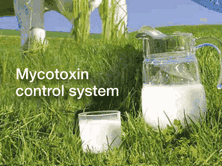 Often the mycotoxins
are concentrated in small areas in corners of feed stores, in the top layers of silage clamps or in small
areas of a field where crops are diseased or stressed.
Often the mycotoxins
are concentrated in small areas in corners of feed stores, in the top layers of silage clamps or in small
areas of a field where crops are diseased or stressed.
Consequently the levels of mycotoxin in a cows diets will vary dramatically week to week, day to day, meal to meal. Every load of feed will be different and the mycotoxin consumed may be contained in a single ear of grain, bite of silage or mouthful of straw.
The situation is even more complex since many mycotoxins interact synergistically and whilst some can be de-activated in the cows rumen others can be transformed into products with even greater toxicity.
Feeds can be tested for specific mycotoxins, usually the six more common mycotoxins found in dairy diets, Aflatoxin, Deoxynivalenol (DON), Zearelenone (ZON), Ochratoxin, Fumonsin, T2.
Sampling errors are very high even with careful sampling technique taking 100 incremental samples from a 20 tonne load the process is very inaccurate and can completely miss mycotoxins that are present. Mycotoxins which are causing an ongoing problem on a farm may be present in very small pockets of dry feed or silage so can easily be missed. Even then there are many other mycotoxins that will not have been tested for.
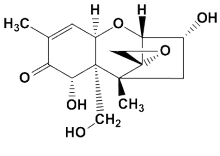 To
suggest that taking a handful of feed out of a complete diet and testing for half a dozen mycotoxins
will give a true representative picture of the maximum levels of each of 500 mycotoxins, which may be
present on a bad day, is a nonsense.
To
suggest that taking a handful of feed out of a complete diet and testing for half a dozen mycotoxins
will give a true representative picture of the maximum levels of each of 500 mycotoxins, which may be
present on a bad day, is a nonsense.
Testing feeds for mycotoxins on commercial farms can be highly misleading and can indicate that mycotoxins are not an issue when in fact they can be causing major problems in performance loss, infertility and ill health of the cows.
Testing feeds for Mycotoxins is a waste of time and can be highly misleading
How common are Mycotoxins in dairy cow diets?
As analytical techniques and our knowledge of mycotoxins has improved in recent years the widespread nature of mycotoxins has become apparent. A recent survey of 83 samples of poultry feed showed that every sample contained multiple mycotoxins. The number of different mycotoxins found in each sample ranged from 7 to 53.
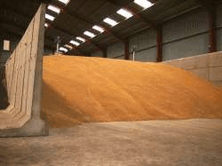 Another mycotoxin survey in 2011 indicated that 74% of feed samples tested positive for
mycotoxins with 41% having two or more mycotoxins at higher than acceptable levels.
Another mycotoxin survey in 2011 indicated that 74% of feed samples tested positive for
mycotoxins with 41% having two or more mycotoxins at higher than acceptable levels.
Cereals can easily become contaminated. Even where the crop in the field is free of contamination high levels of Aflatoxin can result where the crop is harvested at 22% moisture and stored at 20oC to 25oC for less than one week.
Testing of UK wheat samples over a six year period revealed that whilst the levels of mycotoxin contamination varied from year to year, deoxynivalenol (DON) was present in over 80% of samples tested.
Mycotoxins levels found in wheat or other cereals become three times more concentrated in distillers since as starch is removed the mycotoxins are left behind in the distillers. Moist feeds are a particular problem since they deteriorate rapidly on farm often resulting in spoilage and very high levels of toxins towards the end of the load.
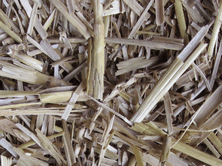 It is not surprising that both UK barley straw and wheat straw which is often baled before it is
fully dry has been shown to be prone to very high levels of mycotoxin contamination. Both deoxynivalenol
(DON) and zearalenone (ZON) have regularly shown very high levels in straw.
It is not surprising that both UK barley straw and wheat straw which is often baled before it is
fully dry has been shown to be prone to very high levels of mycotoxin contamination. Both deoxynivalenol
(DON) and zearalenone (ZON) have regularly shown very high levels in straw.
This is not just a UK problem. Over half of the feedstuffs refused entry into the EU are rejected as a result of mycotoxin contamination.
Mycotoxins are chemically stable and are not destroyed by by feed processing even at high temperatures. In fact the levels of contamination tend to rise over time during storage. Even though cereals and concentrates regularly contain multiple mycotoxins, it is estimated that over 80% of mycotoxins fed to cattle are from forage and straw.
Accept that Mycotoxins are an issue and take action to minimise their impact
Accept that all cattle diets are likely to contain a range of mycotoxins. Do everything possible to minimise the levels of mycotoxins on crops, in feed stores, and on silages. Having done that include a broad spectrum toxin binder in all diets as routine.
Minimise the inclusion of Mycotoxins in cattle diets and feed a toxin binder
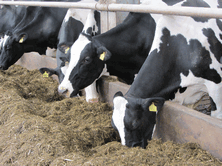 The Effects of Mycotoxins on Cows
The Effects of Mycotoxins on Cows
The symptoms of mycotoxicosis in a dairy herd are not always obvious. Whilst mycotoxins can result in acute and obvious symptoms more often than not effects of mycotoxins are sub-clinical, and non-specific. They can be wide ranging depending on the levels and combinations of different mycotoxins involved, disease challenge, animal welfare, stress and a whole range of other factors.
Recognising when and to what degree mycotoxins are responsible for poor health and performance can be extremely difficult. The effects can be long lasting with cows taking many months to fully recover. It is highly likely that mycotoxins predispose animals to disease and are likely to exaggerate the symptoms of disease and also prolong the effects of a disease. Research clearly shows the effects of mycotoxins on the cows immune system, digestive tract and overall health.
Often mycotoxins problems in Dairy Herds are not obvious
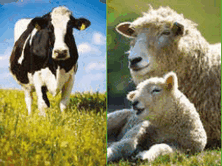 Effects include:
Effects include:
- Reduced feed intake
- Reduced milk output and reduced butterfat %
- Suppression of the immune system
- Decrease in rumen efficiency
- Increased disease susceptibility
- Mycotoxins are anti-microbial resulting in changes to rumen and gut microbes
- Inflammation and damage to the digestive tract, intestinal haemorrhages, scour
- Reduced nutrient absorption and impaired metabolism
- Effects on endocrine and exocrine systems, hormone and enzyme levels
- Metabolic problems, retained placentas, ketosis, displaced abomasums, acidosis
- Infertility, metritis, cystic ovaries, poor conception rates, embryo loss, abortion
- Lameness, laminitis, leg swelling, swollen hocks, liver abscesses, udder oedema
- Increased somatic cell count and mastitis
- Vaccine and drug failures and reduced effectiveness of antibiotics
- Reduced longevity
Mycotoxins are often a factor which is contributing to long standing problems including high disease incidence, poor fertility and lower than expected milk yields.
Mycotoxins affect Cow Health, Performance and Profitability
How best to deal with Mycotoxins
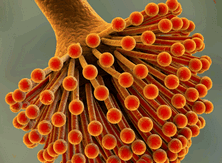 It goes without saying that once the widespread nature of mycotoxins in feedstuffs and their effect
on dairy herd health, fertility, performance and profitability of dairy farms is recognised, then every
effort should be made to minimise the levels of mycotoxins fed to cows.
It goes without saying that once the widespread nature of mycotoxins in feedstuffs and their effect
on dairy herd health, fertility, performance and profitability of dairy farms is recognised, then every
effort should be made to minimise the levels of mycotoxins fed to cows.
Much can be done to reduce mycotoxins levels fed to livestock by improved silage clamp management and good house keeping and hygiene in feed stores and feed troughs for very little extra cost.
There is much that can be done to reduce the impact of Mycotoxins
We can't eliminate mycotoxins altogether but we can grow and harvest cleaner crops. We can reduce the amount of spoilage and mycotoxins which result from forage conservation and silage making by consolidating the crop well, in a clean clamp as quickly as possible after cutting.
We can use the best silage additives and latest clamp sealing systems available and make sure that the silage clamp really is airtight, giving it the attention to detail that it deserves. Doing this will increase the aerobic stability of silages reducing heating and thereby reduce the levels of mycotoxins in the feed.
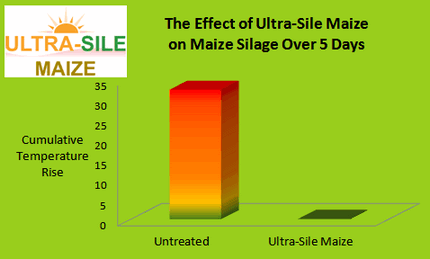
We can avoid over-filling silage clamps. we can make sure that clamp faces are not too big and usage rates are appropriate to avoid spoilage and heating. We can manage silage faces well and discard any spoiled feed.
We can make sure that feed stores are clean and dry and are regularly cleaned between loads.
Make every effort to reduce the levels of Mycotoxins fed to cows
 We can also include a broad spectrum toxin binder in cattle diets as a matter of course. The aim
is to bind a wide range of mycotoxins in the feed as quickly as possible after they are consumed by the
cow before they are absorbed into the blood stream.
We can also include a broad spectrum toxin binder in cattle diets as a matter of course. The aim
is to bind a wide range of mycotoxins in the feed as quickly as possible after they are consumed by the
cow before they are absorbed into the blood stream.
Feed an effective toxin binder to reduce toxin uptake by the cow.
Not all toxin binders are the same.
Ultrabond binds more toxin per gram than many other products.
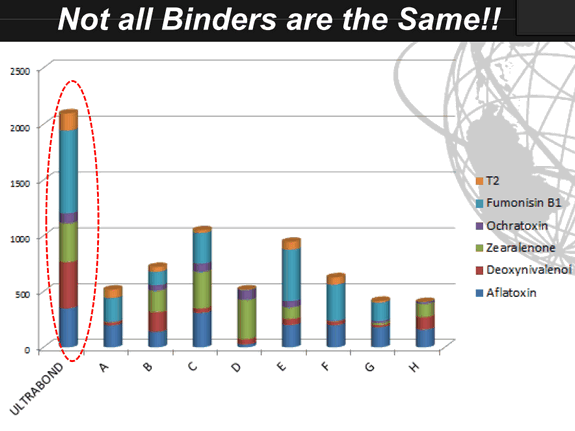
We recommend the use of a toxin binder in all dairy diets especially where
there are
issues with performance, health or fertility
The Benefits of Toxin Binders and Deactivators
It is likely that toxin control will be of long term benefit to dairy cows. Feeding toxin binders should not be seen as a short term quick fix expecting a sizeable milk yield response within a week. Sometimes responses are rapid and large but more often they are not and benefits are seen over several months.
 Particularly where mycotoxins have
been causing problems for a long period of time resulting in under nutrition, damage the intestinal tract,
liver, internal organs, inflammation, lameness, disease issues, infertility and general ill health it
will take an equally long time for the cow to recover.
Particularly where mycotoxins have
been causing problems for a long period of time resulting in under nutrition, damage the intestinal tract,
liver, internal organs, inflammation, lameness, disease issues, infertility and general ill health it
will take an equally long time for the cow to recover.
Expect to start to see some improvements after a month or two and in the longer term look for healthier cows, lower vet and medicine bills, higher butterfat % and milk protein %, improved fertility, a lift in lactation yield, reduced concentrate feed rates and cows staying in the herd for longer. Then you will appreciate the benefits and cost saving of using Ultrabond.
We recommend using a toxin control system routinely in all dairy diets
RWN Product Range
Whilst every effort should be made to minimise the levels of toxins in feeds and conserved forages, in practice some toxins will always be present in farm feeds. Consequently we offer a range of products designed to minimise the adverse effects of toxins on livestock.
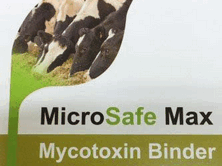 Microsafe Gain and Microsafe Max - Microsafe is based on yeast cell wall material, and selected bentonite clays along with beta glucans to stimulate the cow's immune system into working more effectively. MicroSafe is designed to bind with a wide range of mycotoxins, carrying mycotoxins harmlessly through the animal, without entering the bloodstream.
Microsafe Gain and Microsafe Max - Microsafe is based on yeast cell wall material, and selected bentonite clays along with beta glucans to stimulate the cow's immune system into working more effectively. MicroSafe is designed to bind with a wide range of mycotoxins, carrying mycotoxins harmlessly through the animal, without entering the bloodstream.
Broad spectrum control of mycotoxins increases the ability to protect stock from the performance damaging effects of mycotoxins. Microsafe Gain also contains stabilised yeasts and seaweed with potential additional benefits to rumen flora and enhanced immunity.
Microsafe Max and Microsafe Gain are comprehensive products that have served us well over many years. We have found them to be amongst the most effective binders on the market.
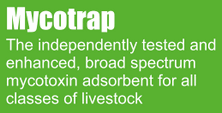 Mycotrap - The specialised mineral complex in Mycotrap has a strong binding capacity for a broad spectrum of mycotoxins in animal feeds helping to reduce toxin related disease,
improve immunity and productivity. Binds mycotoxins at all pH ranges throughout the gut.
Mycotrap - The specialised mineral complex in Mycotrap has a strong binding capacity for a broad spectrum of mycotoxins in animal feeds helping to reduce toxin related disease,
improve immunity and productivity. Binds mycotoxins at all pH ranges throughout the gut.
Independently evaluated and verified at Gent University. Proven to be effective against the eleven most commonly occurring mycotoxins in animal feeds including Aflatoxins, Fumonisin, DON, ZON, T2 and Ochratoxin.
The Anpro Range - is an innovative approach to toxins based on decades of research and verified by independent experts. The Anpro Range consists of Anpro-UB (UltraBond), Anpro Farm Pack and Anpro-Advance Farm Pack
Anpro offers an unparalleled system to bind and entrap a broad spectrum of toxins combined with bioflavanoids, anthocyanins and other phenolic compounds which have strong anti-oxidative effects and empower liver detoxification processes.
Anpro-UB with its broad spectrum activity can bind a wide range of toxins, resulting in a reduced challenge for the cow. On farm trials and testimonials for Anpro-UB have been very positive with good feedback including improvements in dairy cow fertility and in some cases somatic cell counts (SCC) have shown falls of anything up to 50%.
MycoAid - A comprehensive package combining Biocell Live Yeast together with high levels of Yeast Cell Wall, mannan oligosaccharide (MOS) and beta-glucans. Provides risk protection against poor quality and contaminated feed, safeguarding health and production. For those already feeding a live yeast supplement additional protection is provided at a relatively low additional cost.
Mycocell Combi -A combination of Biocell Live Yeast together with toxin binders and deactivators. Based on Biomin's Mycofix offering an alternative approach to traditional binders.
You can't see Mycotoxins but keep toxins under control and you'll see results
For more information or to place an order contact Richard Webster
